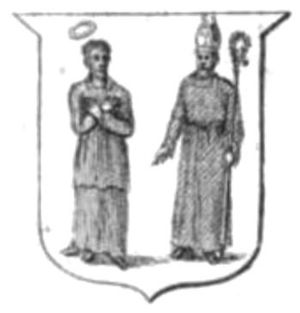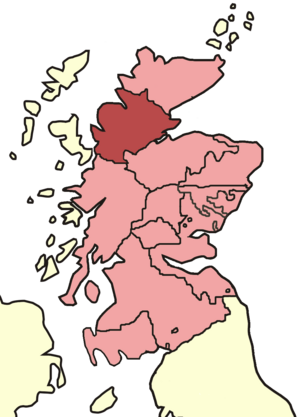Diocese of Ross (Scotland) facts for kids
 |
|
| Head | Bishop of Ross |
|---|---|
| Archdeacon(s) | Archdeacon of Ross |
| Known rural deans | Dingwall, [not known] |
| First attestation | 1127 x 1131 |
| Metropolitan before 1472 | None |
| Metropolitan after 1492 | Archbishop of St Andrews |
| Cathedral | Fortrose Cathedral |
| Previous cathedral(s) | Rosemarkie (?) |
| Dedication | St Peter |
| Native dedication | St Boniface (or Curetán) |
| Canons | Secular |
| Mensal churches | Nigg, Tarbat |
| Common churches | Applecross, Gairloch, Kintail, Lochalsh, Lochbroom, Lochcarron |
| Prebendal churches | Alness, Ardersier (Dean), Avoch (Abbot of Kinloss), Contin, Cullicudden, Dingwall, Edderton (Subdean), Fodderty (archdeacon), Inverferan (Succentor), Kilchrist, Killearnan (Archdeacon), Kilmorack (Precentor), for a brief time held by the Chancellor), Kilmuir Easter, Kilmuir Wester (Dean), Kiltearn, Kincardine, Kinnettes (Chancellor, held briefly by Precentor), Kirkmichael, Lemlair (briefly held by Archdeacon), Logie Easter, Logie Wester (Treasurer, briefly held by Archdeacon), Newnakle, Nigg (Bishop), Rosemarkie, Roskeen, Suddy (Precentor), Tain (Subdean), Tarbat (Bishop), Urquhart (Treasurer), Urray (Succentor) |
| Catholic successor | Merged into resurrected Diocese of Aberdeen, 4 March 1878 |
| Episcopal successor | Diocese of Moray, Ross and Caithness |
The Diocese of Ross was an important church area in the Highlands of Scotland during the Middle Ages and later. A diocese is like a region managed by a bishop. This one was led by the Bishop of Ross.
The main church, called a cathedral, was in Fortrose. Before that, the bishops were based in Rosemarkie. The diocese had an Archdeacon, who was a senior church official. The first known Archdeacon appeared around 1223. There was also a Dean of Christianity, who looked after local church matters.
Contents
Who Ran the Church?
The cathedral had a group of leaders called a cathedral chapter. These officials helped the bishop run the diocese.
- A Dean was first recorded around 1212. They were a main leader of the chapter.
- A Subdean helped the Dean and was first mentioned in 1356.
- A Precentor (sometimes called a Chanter) was in charge of music and singing. This role appeared around 1255.
- A Succentor helped the Precentor with the music.
- A Chancellor was responsible for the diocese's records and education. This role was first noted around 1212.
- A Treasurer managed the money and property of the diocese. This role began around 1227.
Changes Over Time
After the Scottish Reformation in 1560, big changes happened in the Scottish church. The Presbyterian Church of Scotland stopped having bishops. However, the Roman Catholic Church continued to appoint bishops who were connected to the Holy See (the Pope).
For a while, bishops were brought back to the Church of Scotland between 1661 and 1688. But after the Glorious Revolution of 1688, having bishops was permanently stopped in the main church in Scotland. From the early 1700s, the Scottish Episcopal Church continued to have bishops in Scotland.
Where Was Ross?
In the 1100s, this church area was often called "Rosemarkie." Later, it became known as Ross. The Diocese of Ross covered roughly the same area as the old county of Ross (also known as Ross-shire).
Local Church Areas
The Diocese of Ross was made up of many smaller church areas called parishes. Each parish had its own local church and priest. Here is a list of some of these parishes:
- Alness
- Altyre (Kilmorack)
- Applecross
- Ardersier (an area geographically in Moray but part of Ross diocese)
- Avoch
- Contin
- Cromarty
- Cullicudden
- Dingwall
- Edderton
- Eddyrdor (Killearnan)
- Fodderty
- Fortrose Cathedral
- Gairloch
- Inveraferan (Urray)
- Kilmoremethet (Kilmuir Easter)
- Kilmuir Wester
- Kiltearn
- Kincardine
- Kinnettes
- Kintail
- Kirkmichael
- Lemlair
- Lochalsh
- Lochbroom
- Lochcarron
- Logiebride (Logie Wester)
- Logiemethet (Logie Easter)
- Nigg
- Nonikiln/Newnakle (joined with Rosskeen by 1274)
- Rosemarkie
- Rosskeen
- Suddie
- Tain
- Tarbat
- Tarradale (Kilchrist)
- Urquhart
Rosemarkie: A Special Title
In 1973, the name Rosemarkie was used again by the Catholic Church. It became a "titular see." This means it's a historical title for a bishop, not an active diocese with land. It has had three bishops hold this special title.


